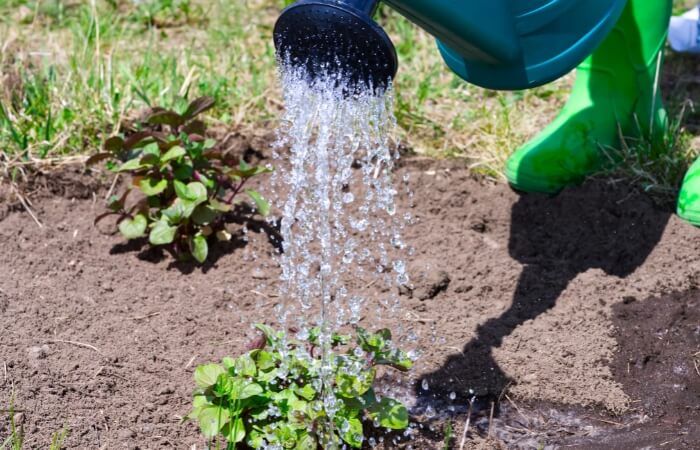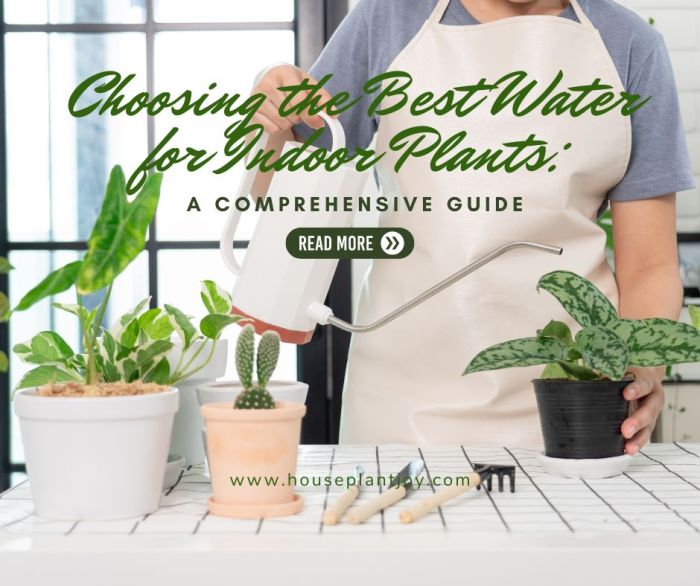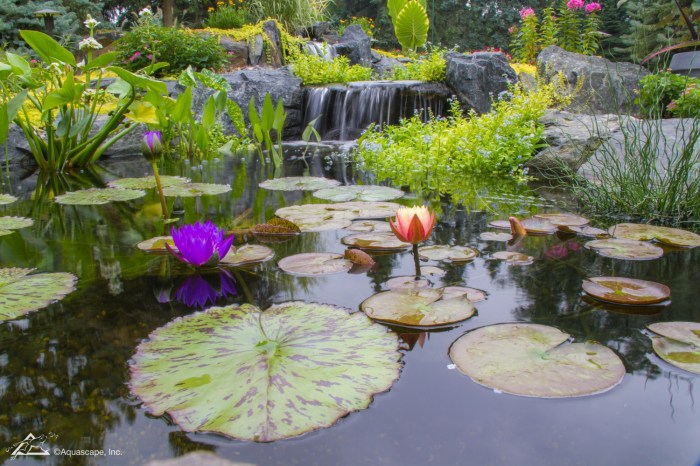What Water is Best for Plants?
Types of Water for Plants
What water is best for plants – Choosing the right water for your plants can significantly impact their health and growth. Different water sources have varying chemical compositions, affecting nutrient availability and potentially introducing harmful substances. This section compares tap water, rainwater, bottled water, and well water, highlighting their suitability for plant irrigation.
Comparison of Water Sources for Plant Irrigation

Source: backyarddigs.com
| Water Type | pH Level | Mineral Content | Potential Contaminants |
|---|---|---|---|
| Tap Water | Variable (typically 6.5-8.5); can be adjusted. | Varies depending on location; may contain chlorine, fluoride, and other minerals. | Chlorine, fluoride, heavy metals (depending on location). |
| Rainwater | Slightly acidic (around 5.6); can vary based on air pollution. | Generally low; may contain small amounts of dissolved minerals and nutrients. | Airborne pollutants, such as heavy metals or pesticides. |
| Bottled Water | Variable, depending on the brand and source; usually within a neutral range. | Varies depending on the source; often purified to remove minerals. | Generally low; potential for plastic leaching if stored in plastic bottles. |
| Well Water | Variable, highly dependent on the geological composition of the area. | High mineral content; may contain significant amounts of salts, iron, or other minerals. | Bacteria, nitrates, arsenic, and other contaminants depending on the well’s location and condition. |
The chemical composition of each water type directly impacts plant growth. For instance, high salinity in well water can inhibit root growth, while chlorine in tap water can damage plant tissues. Rainwater, while generally beneficial, may lack essential nutrients for optimal plant health. Bottled water, often purified, can be suitable but may lack the beneficial minerals found in other sources.
The ideal water type depends on the specific plant and the local water quality.
Water Quality and Plant Health
Several water parameters significantly influence plant health. Understanding how pH, mineral content, chlorine, and fluoride affect plants is crucial for successful gardening.
Effects of Water Parameters on Plant Health

Source: houseplantjoy.com
The pH of water affects nutrient availability. A pH that’s too acidic or alkaline can prevent plants from absorbing essential nutrients, leading to deficiencies. Excessive mineral content can lead to salt buildup in the soil, causing toxicity and hindering growth. Chlorine and fluoride, often found in tap water, can be toxic to plants in high concentrations, damaging leaves and roots.
Specific deficiencies or excesses manifest differently in plants. For example, iron deficiency causes chlorosis (yellowing of leaves), while excessive boron can lead to leaf burn and stunted growth.
A Simple Experiment on Water pH and Plant Growth, What water is best for plants
To demonstrate the effect of varying water pH on plant growth, a simple experiment can be conducted. Three identical plants of the same species are grown in separate containers using identical soil and sunlight conditions. One plant is watered with water at a neutral pH (around 7), another with slightly acidic water (pH 6), and the third with slightly alkaline water (pH 8).
The growth and health of each plant are monitored over several weeks, noting differences in height, leaf color, and overall vigor. This experiment demonstrates how pH directly impacts plant health.
Water Treatment for Plants

Source: aquascapes.com
Improving tap water quality for plant use is essential, especially if your tap water contains high levels of chlorine, fluoride, or other undesirable elements. Several methods can be employed to achieve this.
Methods for Improving Tap Water Quality
Letting tap water sit out for 24 hours allows chlorine to dissipate. Filtering water through a carbon filter can further remove chlorine and other impurities. pH adjusters, such as diluted lemon juice or baking soda, can be carefully used to modify the pH to a more suitable range for your plants. However, always proceed cautiously with pH adjusters, as incorrect adjustments can harm plants.
Reducing Chlorine and Fluoride Levels
Allowing tap water to sit overnight significantly reduces chlorine levels. Using a water filter specifically designed to remove chlorine and fluoride is a more effective method. Boiling water can also reduce chlorine levels but does not affect fluoride.
Preparing Rainwater for Irrigation
Collecting rainwater for plant irrigation is a beneficial practice. However, ensure the collection container is clean to prevent contamination. Rainwater should be collected in a clean container, preferably one made of non-toxic material, away from sources of pollution. The water can be used directly or stored in a covered container, ideally within a few days of collection to prevent the growth of algae or bacteria.
Plant-Specific Water Needs: What Water Is Best For Plants
Different plants have unique water requirements. Understanding these needs is crucial for healthy plant growth. This section details the water requirements of various plant types, including watering frequency and preferred water type.
Watering Frequency and Water Type for Different Plants
- Succulents: Infrequent watering; well-draining soil; tap water or rainwater is suitable.
- Ferns: Frequent watering; consistently moist soil; prefer rainwater or filtered water.
- Tomatoes: Regular watering; well-drained soil; tap water or rainwater is suitable, ensuring the water isn’t too cold.
- Roses: Regular watering; well-drained soil; rainwater or filtered water is preferred.
- Orchids: Watering frequency varies by species; well-draining medium; rainwater or filtered water is preferred.
Environmental factors such as temperature, humidity, and sunlight significantly influence a plant’s water needs. Plants in hot, sunny locations require more frequent watering than those in cooler, shaded areas. High humidity reduces the need for frequent watering, while low humidity increases it.
Signs of Improper Watering
Overwatering and underwatering both have distinct visual signs. Recognizing these symptoms is essential for timely intervention and plant rescue.
Symptoms of Overwatering and Underwatering
Overwatering: Yellowing lower leaves, wilting despite moist soil, soggy soil, leaf drop, and eventually root rot (roots turn brown and mushy). The plant may appear droopy even though the soil is wet. A foul odor may emanate from the soil.
Underwatering: Dry, brittle soil; wilting leaves that don’t recover when watered; leaf edges browning and crisping; leaf curling; stunted growth. The plant’s overall appearance will be dry and shriveled. The soil will be visibly dry and crumbly.
Water Conservation Techniques
Efficient watering techniques significantly reduce water consumption while maintaining plant health. This section explores various methods for conserving water during plant irrigation.
Comparison of Watering Methods
| Watering Method | Water Efficiency | Cost-Effectiveness | Advantages |
|---|---|---|---|
| Drip Irrigation | High | Moderate | Precise water delivery, minimizes water waste. |
| Soaker Hoses | High | Low | Simple to use, effective for larger areas. |
| Mulching | High | Low | Reduces evaporation, suppresses weeds. |
| Overhead Sprinklers | Low | Low | Easy to install, but significant water loss through evaporation. |
FAQ Explained
Can I use distilled water for my plants?
While distilled water is pure, it lacks essential minerals plants need. Prolonged use can lead to nutrient deficiencies. It’s best used sparingly or supplemented with nutrients.
How often should I check my water’s pH?
Regularly checking your water’s pH, at least once a month, is advisable, especially if you notice changes in plant health or are using tap water.
What are the signs of chlorine damage in plants?
Chlorine damage can manifest as leaf burn, yellowing, or wilting. The severity depends on the chlorine concentration and plant sensitivity.
My plants are wilting, is it overwatering or underwatering?
Wilting can indicate both. Check the soil moisture; if it’s soggy, it’s overwatering; if it’s dry, it’s underwatering. Examine the roots for rot (overwatering).




















